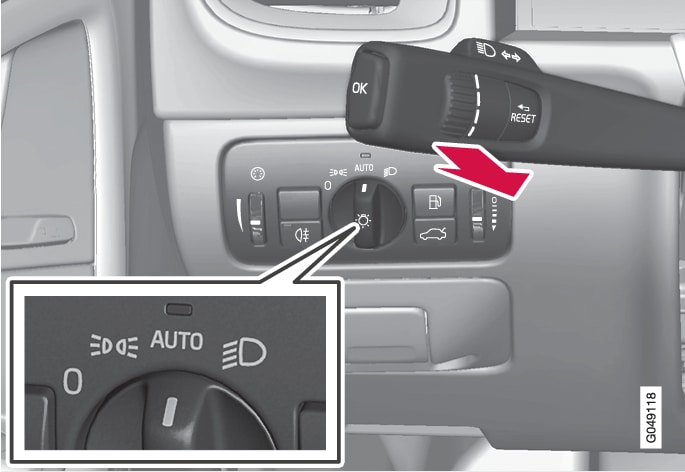Active high beam - AHB
Active high beam (Active High Beam - AHB) is a function which uses a camera sensor at the top edge of the windscreen to detect the headlamp beams of oncoming traffic or the rear lights of vehicles in front, and then switches from main beam to dipped beam. The function can also take streetlights into account.
Car with halogen headlamps
The lighting returns to main beam about a second after the camera sensor no longer detects the headlamp beams from oncoming traffic or the rear lights from vehicles in front.
Car with Xenon headlamps
Unlike what happens during conventional dimming, the light beam continues with main beam on both sides of oncoming traffic or vehicles ahead - only the part of the light beam that points directly to the vehicle is dimmed.

The lighting returns to full main beam about a second after the camera sensor no longer detects the headlamp beams from oncoming traffic or the rear lights from vehicles in front.
Activating/deactivating
AHB can be activated when the headlamp control's knob is in position  (provided that the function has not been deactivated in the menu system MY CAR, see MY CAR).
(provided that the function has not been deactivated in the menu system MY CAR, see MY CAR).

The function can start while driving in the dark when the car's speed is 20 km/h or higher.
Activate/deactivate AHB by moving the left-hand stalk switch towards the steering wheel to the end position and then releasing. Deactivation when main beam is on means that the lights are reset directly to dipped beam.
When AHB is activated the  symbol turns white in the instrument's information display.
symbol turns white in the instrument's information display.
When main beam is activated, the symbol turns blue. This also applies for Xenon headlamps if the main beam is partially dimmed, i.e. as soon as the light beam shines with slightly more than dipped beam.
Manual operation
Note
Keep the windscreen surface in front of the camera sensor free from ice, snow, mist and dirt.
Do not stick or attach anything to the windscreen in front of the camera sensor as this may reduce effectiveness or cause one or more of the systems dependent on the camera to stop working.
If the message Active main beam Temporary unavailable Switch manually is shown in the combined instrument panel's information display then you have to switch manually between main and dipped beam. However, the knob for headlamp control can still remain in position  . The same applies if the message Windscreen sensors blocked See manual and the
. The same applies if the message Windscreen sensors blocked See manual and the  symbol are shown. The
symbol are shown. The  symbol goes out when these messages are shown.
symbol goes out when these messages are shown.
AHB may be temporarily unavailable e.g. in situations with dense fog or heavy rain. When AHB becomes available again, or the windscreen sensors are no longer blocked, the message extinguishes and the  symbol illuminates.
symbol illuminates.
Warning
AHB is an aid for using the optimum beam pattern when conditions are favourable.
The driver always bears responsibility for manually switching between main and dipped beam when traffic situations or weather conditions so require.
Important
Examples of when manual switching between main and dipped beam may be required:
- In heavy rain or dense fog
- In freezing rain
- In snow flurries or slush
- In moonlight
- When driving in poorly lit built-up areas
- When the traffic ahead has weak lighting
- If there are pedestrians on or beside the road
- If there are highly reflective objects such as signs in the vicinity of the road
- When the lighting from oncoming traffic is obscured by e.g. a crash barrier
- When there is traffic on connecting roads
- On the brow of a hill or in a hollow
- In sharp bends.
For more information on the limitations of the camera sensor, see Collision warning system - camera sensor limitations.